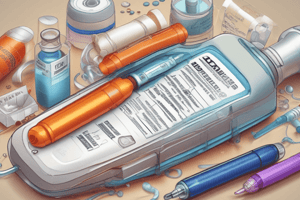Podcast
Questions and Answers
What should be done if a patient's blood glucose level is less than 70 mg/dL?
What should be done if a patient's blood glucose level is less than 70 mg/dL?
- Give a moderate dose of insulin.
- Begin hypoglycemic protocol and call provider. (correct)
- Administer corrective insulin immediately.
- Continue with scheduled blood glucose checks.
What action should be taken if a patient is NPO?
What action should be taken if a patient is NPO?
- Increase insulin doses due to lack of intake.
- Administer prandial insulin as needed.
- Follow the NPO grid and use the insulin sensitive/low dose scale. (correct)
- Stop all insulin administration.
What should be done for a blood glucose level exceeding 400 mg/dL?
What should be done for a blood glucose level exceeding 400 mg/dL?
- Start emergency correctional protocol.
- Call the provider. (correct)
- Continue current treatment regime.
- Administer high dose insulin.
In which scenario should prandial insulin be held?
In which scenario should prandial insulin be held?
What insulin adjustments are allowed for patients on cyclic tube feeding?
What insulin adjustments are allowed for patients on cyclic tube feeding?
Which guideline should be followed for administering insulin to patients receiving intermittent tube feeding boluses?
Which guideline should be followed for administering insulin to patients receiving intermittent tube feeding boluses?
What is the maximum dose of insulin for bedtime and midnight coverage unless special feeding conditions are met?
What is the maximum dose of insulin for bedtime and midnight coverage unless special feeding conditions are met?
What is the primary purpose of correctional insulin?
What is the primary purpose of correctional insulin?
Which condition qualifies a patient for the 'Insulin Sensitive/Low dose' scale?
Which condition qualifies a patient for the 'Insulin Sensitive/Low dose' scale?
What symptom is NOT typically associated with hypoglycemia?
What symptom is NOT typically associated with hypoglycemia?
What is the pre-meal blood glucose goal for patients in this protocol?
What is the pre-meal blood glucose goal for patients in this protocol?
Which of the following is NOT an exclusion criterion for the insulin protocol?
Which of the following is NOT an exclusion criterion for the insulin protocol?
When is the hypoglycemic protocol triggered?
When is the hypoglycemic protocol triggered?
How is insulin administered to patients on this protocol?
How is insulin administered to patients on this protocol?
Which medication is an example of prandial insulin?
Which medication is an example of prandial insulin?
What action should be taken when a patient receiving bolus tube feedings is made NPO?
What action should be taken when a patient receiving bolus tube feedings is made NPO?
For a patient with a blood glucose level of 45 mg/dL who is responsive and able to swallow, which treatment is recommended?
For a patient with a blood glucose level of 45 mg/dL who is responsive and able to swallow, which treatment is recommended?
What is the correct management for a patient who is on continuous tube feedings and those feedings are stopped?
What is the correct management for a patient who is on continuous tube feedings and those feedings are stopped?
When a patient receiving both basal and prandial insulin becomes NPO, what actions should be taken?
When a patient receiving both basal and prandial insulin becomes NPO, what actions should be taken?
What is the primary treatment intervention for a patient with a glucose level of 40 mg/dL and no IV access?
What is the primary treatment intervention for a patient with a glucose level of 40 mg/dL and no IV access?
Under what circumstance should a patient remain on the insulin sensitive/low dose scale?
Under what circumstance should a patient remain on the insulin sensitive/low dose scale?
When is correctional insulin only adjusted for NPO patients?
When is correctional insulin only adjusted for NPO patients?
If a patient is unresponsive and has no IV access, what immediate action should be taken?
If a patient is unresponsive and has no IV access, what immediate action should be taken?
Study Notes
Correctional Insulin Dosing Scale
- The correctional insulin scale has three dose levels: Low, Moderate and High
- Insulin sensitivity is determined by factors such as age, weight, eating habits, presence of certain medical conditions, etc.
- The scale is designed to adjust insulin dosage based on blood glucose levels.
- Insulin sensitivity/Low dose is the default level in cases like NPO (nothing per mouth) or hypoglycemia
- Bedtime insulin coverage is capped at 4 units unless the patient is receiving continuous or cyclic enteral feedings.
- The table summarizes the insulin dose ranges for different blood glucose levels.
- For readings over 400 mg/dL, contact a medical professional.
Prandial Insulin
- Prandial insulin is administered within 10 minutes of a meal, either before or after.
- Correctional insulin and prandial insulin doses are given together.
- Hold prandial insulin if the pre-meal glucose is less than 70 mg/dL, notify the provider, and initiate hypoglycemic treatment.
Nutritional and NPO (Nothing Per Mouth) Considerations
- For patients receiving Total Parenteral Nutrition (TPN), the provider responsible for TPNs manages all insulin added to the TPN.
- Continuous Tube Feeding Patients may be prescribed basal and correctional insulin.
- Cyclic Tube Feeding Patients may be prescribed basal and correctional insulin.
- Bolus Tube Feeding patients may be prescribed basal, prandial, and correctional insulin doses.
- NPO patients follow specific blood glucose checks and the Insulin Sensitive/Low dose scale.
- Collaboration with the provider is essential for resuming the previous insulin level once the patient resumes eating.
Insulin Order: Patients NPO for Tests or Procedures
- Correctional Insulin Only: Decrease to the Insulin Sensitive level as soon as the patient is NPO.
- Basal Insulin Only: Give 50% of glargine, detemir, or NPH dose with the next dose. Hold all basal insulin for patients on continuous tube feedings. Type 1 diabetes patients receive 100% of their basal dose.
- Basal and Prandial Insulin: Hold all prandial insulin doses. Continue with the full glargine or detemir insulin dose. Give 50% of the AM NPH dose and 100% of the PM NPH dose.
- Prandial Only: Hold prandial insulin with the next dose.
Meal Type: All Patients who are NPO for Tests or Procedures
- Bolus Tube Feedings: Decrease correctional insulin to the Insulin Sensitive level, stop prandial insulin but continue correctional insulin. Give 50% of the basal dose, unless Type 1 diabetes, then give 100% of the basal dose.
- Continuous or Cyclic Tube Feeding Stopped: Hold basal insulin, unless Type 1 diabetes, then give 50% of the dose.
Key Point
- The Insulin Sensitive/Low dose scale is maintained until the provider orders advancement.
Hypoglycemia Treatment (for Glucose less than 70 mg/dL)
- Responsive patients: 4 oz of juice or Instant Glucose 37.5 gm (1 tube)
- Unresponsive patients with IV Access: Dextrose 50% 25 mL IV x1
- Unresponsive patients without IV Access: Glucagon 1 mg IM once. Call rapid response team and physician to obtain IV access.
Prandial Insulin Examples
- Lispro (Humalog)
- Regular insulin (Novolin R)
Correctional Insulin
- Short-acting insulin given for hyperglycemia measured before the meal.
Insulin Sensitive
- Patients with a single blood glucose below 70 mg/dL or these conditions:
- Kidney failure (creatinine greater than 2)
- Liver failure
- Age 70 or older
- Adult patients under 50 kg
- Erratic eating habits
- Insufficiently treated Addison's disease or other endocrinological glandular failure
Hypoglycemia Symptoms
- Mental status changes (concentration, coordination, weakness, lethargy, blurred vision, confusion)
- Sweating
- Anxiety
- Palpitations
- Hunger
- Tremor
Policy
- This protocol is intended for non-ICU patients with diabetes or those without diabetes who may have hyperglycemia due to medical or surgical reasons.
- Provides options for short-term correctional (less than 48 hours) or longer-term "Basal-Prandial" approaches to normalize blood glucose.
- Assumes the use of basal AND prandial insulin.
- Blood glucose goal before meals is less than 140 mg/dL.
- All blood glucoses below 70 mg/dL should be treated with the Hypoglycemia Protocol and patients placed on the 'Insulin Sensitive/Low dose' scale.
Exclusion Criteria
- Diabetic ketoacidosis
- Pancreas transplant patients: Glycemic assessment is required to rule out organ rejection. The Transplant Team Providers will decide if the protocol can be used.
Protocol
- The provider orders basal insulin, prandial insulin, initial correctional insulin level, and blood glucose testing schedule via the GPU Glycemic Control - Subcutaneous insulin electronic order set.
- Based on these orders, the RN administers the appropriate correctional dose of lispro insulin according to the correctional insulin dosing scale.
- Correctional and prandial insulin are administered together subcutaneously.
- All patients on the protocol will have a Glycated Hemoglobin (Hemoglobin A1C) measured.
Studying That Suits You
Use AI to generate personalized quizzes and flashcards to suit your learning preferences.
Related Documents
Description
This quiz covers the principles of correctional and prandial insulin dosing. It includes details on dose levels, insulin sensitivity, and when to contact a medical professional. Test your knowledge on insulin management for blood glucose control.




